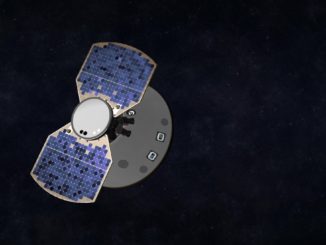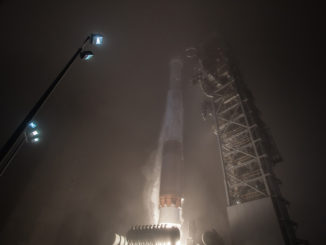
NASA’s robotic InSight Mars lander arrived at Vandenberg Air Force Base in California this week aboard a U.S. Air Force cargo plane, ready for final testing, fueling and launch aboard an Atlas 5 rocket May 5, two years later the originally planned.
Carried aboard an Air Force C-17 transport plane, the spacecraft touched down on Vandenberg’s runway Wednesday afternoon after a trip from Buckley Air Force Base, Colorado, near Lockheed Martin’s spacecraft manufacturing facility in Denver.
“The Air Force C-17 crew from the 21st Airlift Squadron gave us a great ride,” said Tom Hoffman, InSight project manager, from NASA’s Jet Propulsion Laboratory in Pasadena, California. “Next time InSight travels as high and as fast, it will be about 23 seconds into its launch, on the way to Mars.”
Teams transferred InSight, which took the trip inside an environmentally-controlled container, to an Astrotech clean room on the base, where engineers unpacked the lander from its shipping box Thursday to begin several weeks of checkouts and tests.
InSight’s launch window May 5 opens at 4:05 a.m. PDT (7:05 a.m. EDT; 1105 GMT) and extends for two hours. The mission has until June 8 to launch and reach Mars for an automated landing Nov. 26.
The mission will be the first planetary probe to launch from Vandenberg Air Force Base.
The spacecraft was supposed to launch in March 2016, but problems sealing a vacuum enclosure containing one of the lander’s primary instruments, a seismometer, forced officials to postpone the mission. Mars launch opportunities come once every 26 months, when the planets are in the proper positions in the solar system, so the next chance to send InSight to the red planet is in May.
The seismometer sensors are now healthy, their enclosure sealed, and are ready for launch. The InSight spacecraft itself, along with a German-built heat probe sensor and the United Launch Alliance Atlas 5 rocket, were all in position at Vandenberg for the March 2016 launch when NASA managers decided in December 2015 to keep the mission on the ground.

Officials flew the InSight spacecraft back to its Lockheed Martin factory after NASA’s decision, and placed the lander in storage until last year, when the redesigned seismometer package arrived from France. Technicians installed the seismometer on the lander, then put the craft through a series of thermal, vacuum and acoustic tests to ensure it will survive the journey to Mars.
“We really wrung out everything on the vehicle,” said Scott Daniels, Lockheed Martin’s assembly, test and launch operations manager for InSight. “This time around, we had all the flight components in, and we got a lot of good performance testing and environmental testing that gives us confidence that we’re ready to launch.”
InSight is already in its launch configuration, with the lander cocooned inside a heat shield and back shell that will protect it during the cruise to Mars, and then during entry into the Martian atmosphere.
Once ground crews place InSight on a rotation fixture in the clean room, they will begin testing the spacecraft to ensure it was undamaged during the trip from Colorado to California. Engineers will also upload a final version of InSight’s flight software program into the lander’s computer, Daniels said in an interview.
“Once we get it checked out, they’ll take the heat shield off of it again, which exposes the bottom of the spacecraft,” said Bruce Banerdt, InSight’s principal investigator at NASA’s Jet Propulsion Laboratory. “That will allow them to make the final connections that we need to make in order to run all the verification tests on the electronics to make sure everything is fine after shipment, and allow us access to fill the propellant tanks.”
Workers will load helium pressurant and hydrazine fuel into the spacecraft later this month, then engineers will ready InSight to meet its Atlas 5 booster, a process that includes encapsulating the probe inside the Atlas 5’s nose cone.
“We stay in the launch configuration,” Daniels said. “There’s really a limited number of things that we have access to and also a limited of number of things we’re really going test while we’re there. It’s pretty close to a ‘ship and shoot’ for a NASA mission.”
“We integrate with the payload adapter, do the final heat shield installation, close out, do the encapsulation, and drive out to the pad,” Daniels said.
The Atlas 5 rocket originally assigned to launch InSight, designated AV-062, instead launched with the WorldView 4 Earth-imaging satellite in November 2016. A different Atlas 5 vehicle, numbered AV-078, is currently at Vandenberg, where it could be stacked on the launch mount at Space Launch Complex 3-East as soon as this weekend.

Plans to transfer the Atlas 5’s first stage to the Vandenberg launch pad Friday were thwarted by heavy rainfall at the West Coast launch base.
Once the first stage is lifted vertical inside the launch pad’s mobile service gantry, ULA’s team will hoist a Centaur upper stage atop the rocket. After a series of rocket tests, InSight will join the Atlas 5 at the launch pad in mid-April.
InSight will launch on the lightest version of the Atlas 5 family — known as the “401” configuration — with no solid rocket boosters and a four-meter (13-foot) diameter payload fairing.
InSight could launch from Florida or California, but ULA and NASA agreed to launch InSight from Vandenberg to reduce the Atlas 5 team’s workload at Cape Canaveral, where up to a half-dozen flights are planned this year. InSight is the only Atlas 5 mission set for launch from Vandenberg in 2018.
Lockheed Martin built the InSight lander on the design of the Phoenix probe, which touched down on Mars in 2008. Phoenix launched from Cape Canaveral in 2007 on a smaller Delta 2 rocket, a launcher set for retirement later this year, and InSight’s mass at launch is well below the maximum interplanetary lift capability of even the lightest Atlas 5 configuration.
That means InSight does not require the extra boost of energy a rocket would obtain from the Earth’s rotation by launching to the east from Cape Canaveral. The Atlas 5 launching InSight will instead head south over the Pacific Ocean from Vandenberg, which is located around 140 miles (225 kilometers) northwest of Los Angeles.
Two CubeSats developed at JPL will accompany InSight on the launch. Once they arrive near Mars, the CubeSats will relay telemetry from InSight back to Earth as the probe descends through the Martian atmosphere.
But the experimental nano-probes are secondary to InSight’s mission, and the lander’s success will not depend on the CubeSats.
InSight will touch down at Elysium Planitia, a broad plain just north of the Martian equator, and use a robotic arm to place its seismic enclosure on the Martian surface to listen for quakes. The lander’s heat probe will burrow to a depth of around 16 feet, or 5 meters, to measure the amount of heat escaping the planet’s interior.
The seismometer instrument will be able to measure ground movements as small as half the radius of a hydrogen atom, NASA said, to sense minor shaking that may originate deep inside Mars. No mission has made a confirmed detection of “marsquakes” before, but instrumentation left behind by the Apollo astronauts discovered such tremors on the moon.
Scientists want to know about the structure of Mars’ interior, and they say InSight’s findings will help their understanding of how rocky planets, including Earth, formed in the early solar system.
NASA officials were uncomfortable launching InSight with a faulty seismometer instrument because the sensor package’s measurements are central to the mission’s overall objectives.
CNES, the French space agency, is responsible for providing the seismic instrument.
The InSight mission’s budget from NASA was originally $675 million, but the two-year delay will push the cost above $800 million. Those figures do not include funding from CNES and DLR, the German space agency, for InSight’s two main instruments.
The cost of the delay was primarily borne by NASA, but CNES was also on the hook for some of the instrument rework, officials said.

In an interview Thursday with Spaceflight Now, Banerdt said U.S. and French engineers jointly redesigned the thermal vacuum enclosure containing the seismic sensors.
“The basic structure of it is the same as it was before, but we looked at all the connections, all the welds, everything in the vacuum container that might possibly be a problem, beefed it up, made it more robust in just about every way that we could, and even put some materials on the inside that would absorb gases, mostly for gases that would come off things like adhesives — outgassing on the inside of the container — but also would be able to somewhat mitigate a small leak on Mars as well,” he said.
The enclosure passed a vacuum leak check last year before the seismometer team shipped the instrument to the United States from France.
“We went and tested the living bejesus out of it, in every way that we would,” Banerdt said. “And it passed all our tests with flying colors before we even put the seismometers inside one. We had a qualification model that was identical to what we were going to use for flight and tested it to much more extreme conditions than the flight model will ever see, and had absolutely no problems. We all believe that we’ve got a really, really solid vacuum enclosure for the seismometer.”
Scientists also used the two-year delay to upgrade the seismic package, and make the instrument more sensitive to quakes on Mars.
“We went back and did a little bit of work on the seismometer sensors themselves — the so-called VBBs, or Very Broadband Sensors — and beefed them up a little bit and tweaked their performance based on some of the testing that we did for the 2016 launch opportunity,” Banerdt said. “We were able to just change a few components in the electronics to get about a factor of two-and-a-half better performance out of the seismometers.
“We really did not want to slip this these two years, but I think we took really good advantage of the opportunity that we had in order to make the whole system more reliable and better performing,” he said.
Email the author.
Follow Stephen Clark on Twitter: @StephenClark1.



